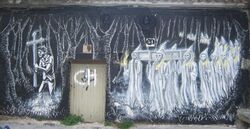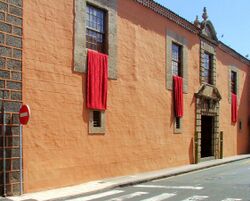Unsolved:Ghosts in Spanish-speaking cultures
There are many stories of ghosts in Spanish-speaking cultures. The Spanish language is second only in number of native speakers to Mandarin Chinese, the tongue of over 360 million people. Ghost stories exist throughout Spanish-speaking America and in Spain.
Argentina
In the Pampas, and particularly in Carro Quemado, the ghost of a colonel on horseback galloping in search of his soldiers killed by the Indians appears from time to time.
In a dwelling in Neuquén in the Patagonia region of Argentina, there are sudden strange fires that the fire department is unable to explain, and in which some have seen ghost appearances.
In the city of Buenos Aires is said that in the church "St. Felicitas", located between Finch Street and Isabel La Católica, you can spot the ghost of Felicitas Guerrero and that if a tissue is left in the church at night, the next day it appears bathed with tears.
Mexico
There is extensive and varied belief in ghosts in Mexican culture. The modern state of Mexico before the Spanish conquest was inhabited by diverse peoples such as the Maya and Aztec, and their beliefs have survived and evolved, combined with the beliefs of the Spanish colonists. The Day of the Dead incorporates pre-Columbian beliefs with Christian elements. Mexican literature and movies include many stories of ghosts interacting with the living.
Peru
Ghosts that appear on the second floor of Casa Matusita in downtown Lima, at the intersection of Avenues Spain and Garcilaso de la Vega, seem to be particularly intense, including poltergeists and apparitions, and it is said that the Argentine comedian Humberto Vera Vilchez was driven mad there. The legend is that a man lived in this house who mistreated his two servants. One day, when he offered a lunch to some guests, the servants decided to get revenge and put a substance in food, not to kill his boss, but to cause mental disorders. After serving and while awaiting results of their macabre plan, they suddenly heard noises and screams coming from the room and came back. The picture was terrifying: mangled bodies everywhere, blood on the walls, on the table, on the ground, all the guests, including his boss, had found a tragic death, violent and terrifying. The curious thing about this house is that the paranormal events happen on the second floor and therefore the first floor is rented. It is said that no one can spend five minutes there.
The Castillo Real Felipe is located in the city of El Callao port of the capital Lima. Among other legends are that the ghost of an eighteenth-century viceroy appears every night on the stairs and rooms of the castle dungeons, leading many soldiers. Also, chilling screams are heard in the dungeons.
Spain
The Galician Santa Compaña Guestier Asturian or Estadea, Estantiga or phantom Castilian is an ancient procession of candle-lit ghosts that gives very bad luck and portends death, like the banshee in Ireland.
La Velilla bell has long sounded in Aragon with nobody touching it to warn of the deaths and deaths of notable people, kings, emperors and so on. Father Benito Jerónimo Feijóo y Montenegro attempted to rationalize the fact without getting much clearer.
The House of Seven Chimneys of Madrid is haunted by the ghost of a young bride who died of sorrow when her husband, a young captain, died in the Battle of San Quentin. In the same place his father committed suicide by hanging himself in one of the beams of the mansion. It is said that she was the mistress of the king, who sent her husband into battle to die, and subsequently the father imprisoned the young woman to commit incest. A white lady appears bearing a torch on certain nights. There is also talk of a girl married to a rich old man who was stabbed to death in his basement.
On the island of Tenerife lies the Lercaro Palace, now the Museum of the History of Tenerife, located in the city of San Cristóbal de La Laguna. In this mansion legend appears the ghost of Catalina Lercaro, who according to legend committed suicide by throwing herself into a well of her mansion when she was forced to marry a man she did not love. It is one of the most famous ghost stories in Spain.
On Monasterio de Madrid street there is an antiquarian shop, "El baúl del monje", in a house where a lawyer was killed earlier in a violent fire. When renovations were undertaken in 1998 of the most violent poltergeist episodes occurred to have been documented in Spain: lamps moved, objects and statues moved and collided, doors slammed, there were strange noises, furniture was placed in the corridor to block passage, and out of circulation coins, buttons, broken glass and chunks of charred wood fell from the roof. Electromagnetic distortions cancelled the Earth's magnetic field, bringing it to zero.
Perhaps the first documented case of poltergeists in Spain was in 1724, when the doctor and writer Diego de Torres Villarroel went called to the house of the Countess of Arcos, located on Fuencarral to witness a paranormal phenomenon. He himself wrote in his life: "I can assure that for fifteen nights I was sleepless and restless, I heard horrible noises ... so out of natural order, such as the pictures being taken down without falling from the nail or the ring, locked doors being opened, plates rolling without breaking ..." All the servants had locked themselves away from fear of suffering from the phenomena, which consisted of repeated blows and movements of objects. The poet watched the fall of several tables in a room. He could not find the source of these sounds, although it was clear that this was not a joke.
The Conde Estruch is a Spanish-Catalan version of Count Dracula, but since the Castillo de Llers was destroyed in the Civil War, he has nowhere to appear.
Sevilla is a city with a rich history that also has quite a few ghosts. The best documented is that of Sister Ursula, a nun of the Order of Charity who appears in the Hospital of the Five Wounds, a Renaissance building which now houses the Parliament of Andalusia. Wander through the corridors of the building and frequent sick room and the old sacristy. The Diputación de Sevilla ghosts wander the corridors of the old barracks. No one dares to walk along the Green Street last Friday night of each month, where there is a narrow passage from the old Jewish quarter. There is also a gentleman in a cloak and ruff inhabiting the high street pharmacy Franks.
On the palace of the Plaza de Santa Eulalia in Murcia a woman appears every night on the roof screaming terrible cries. In the eleventh century, the Saavedra family lived in the palace and the wife of one of the aristocrats was unfaithful.
On the Castillo de la Concepción in Cartagena a woman appears at night who was sandwiched between the walls. Cries are in the drains of the municipal library Sewer in the evenings. The building was headquarters of the Inquisition in the eighteenth century.
In the former tuberculosis sanatorium in Sierra Espuña, closed in 1962, the ghost of a woman appears and Poltergeist phenomena occur such as windows and doors closing suddenly.
In the palace of the Servants of Jesus Street (Murcia), a nobleman beheaded a novice whom he loved. Since then, strange phenomena occur.
In the Murcia coast several ghosts have been seen, such as a Russian princess who was killed by the owner of the Isla del Barón, or the ghost ship that according to the fishermen have seen in the early hours of the Virgin.
The Cornudilla is a ghost town that belongs to the town of Requena, very close to the villages of Marcos and Ruices. During the fifties there was a lot of paranormal activity there, especially in The House of Noise, of which now only some walls are left standing.
In the pub "El Granero" in the city of Granada a monk named Lorenzo appears. It is in part of the Palacio de Abrantes, which was built in the sixteenth century.
Venezuela
The Silbón (Warbler) according to legend is the ghost of a young man who killed his father to eat his offal, and is therefore doomed to wander like a lost soul forever carrying a bag filled with his family's bones. The ghost was named for its distinctive whistle, an omen of death.[1] A version of the legend in the eastern plains of Colombia says the Silbón is a lost soul of a womanizer who died alone and abandoned and seeks company. Another version says he chases pregnant women, delivering a long, sharp whistle that creates an intense cold that enters through the ears and freezes people. When the whistle is sharp a woman will die, but if it is blurred, a man dies.[2]
See also
- List of ghosts
- Ghost films
- Ghost stories
References
- ↑ "La Leyenda del Silbón de Venezuela" (in es). eMisterios Diario digital del Misterio, Enigmas y lo paranormal. 2009-07-29. http://www.emisterios.com/4/5033/la-leyenda-silbon-venezuela.html.
- ↑ "Leyendas y Mitos > El Silbón". venezuelacoplasyleyendas. http://www.venezuelacoplasyleyendas.com/data/leyendas/index.htm.
External links
- Relatos históricos de fantasmas
- Cronología de apariciones a lo largo de la historia
- Organización Nacional de Investigaciones Parapsicológicas www.onipa.org
- La fantasma de Tasajeras
- El alimento de los fantasmas




